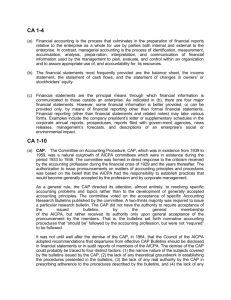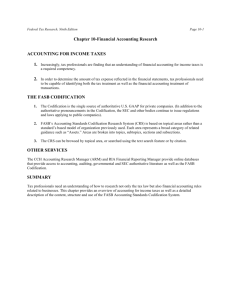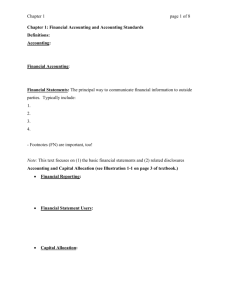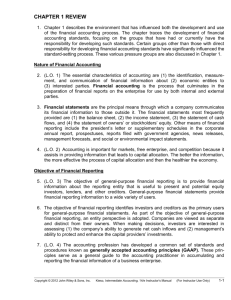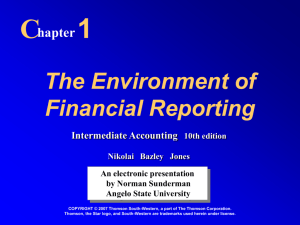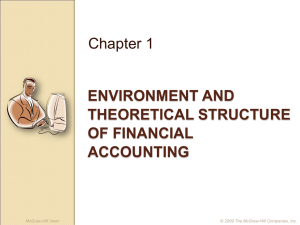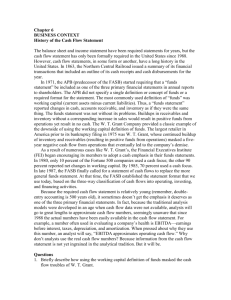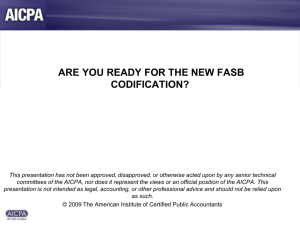CE1-1
advertisement
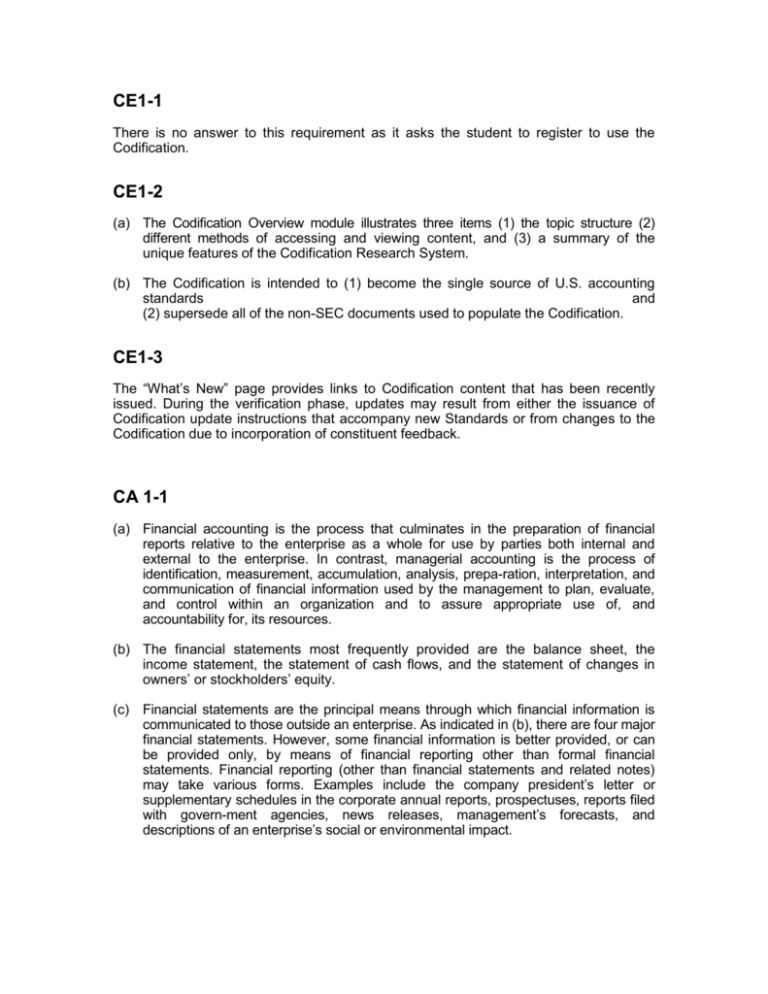
CE1-1 There is no answer to this requirement as it asks the student to register to use the Codification. CE1-2 (a) The Codification Overview module illustrates three items (1) the topic structure (2) different methods of accessing and viewing content, and (3) a summary of the unique features of the Codification Research System. (b) The Codification is intended to (1) become the single source of U.S. accounting standards and (2) supersede all of the non-SEC documents used to populate the Codification. CE1-3 The “What’s New” page provides links to Codification content that has been recently issued. During the verification phase, updates may result from either the issuance of Codification update instructions that accompany new Standards or from changes to the Codification due to incorporation of constituent feedback. CA 1-1 (a) Financial accounting is the process that culminates in the preparation of financial reports relative to the enterprise as a whole for use by parties both internal and external to the enterprise. In contrast, managerial accounting is the process of identification, measurement, accumulation, analysis, prepa-ration, interpretation, and communication of financial information used by the management to plan, evaluate, and control within an organization and to assure appropriate use of, and accountability for, its resources. (b) The financial statements most frequently provided are the balance sheet, the income statement, the statement of cash flows, and the statement of changes in owners’ or stockholders’ equity. (c) Financial statements are the principal means through which financial information is communicated to those outside an enterprise. As indicated in (b), there are four major financial statements. However, some financial information is better provided, or can be provided only, by means of financial reporting other than formal financial statements. Financial reporting (other than financial statements and related notes) may take various forms. Examples include the company president’s letter or supplementary schedules in the corporate annual reports, prospectuses, reports filed with govern-ment agencies, news releases, management’s forecasts, and descriptions of an enterprise’s social or environmental impact. CA 1-7 (a) CAP. The Committee on Accounting Procedure, CAP, which was in existence from 1939 to 1959, was a natural outgrowth of AICPA committees which were in existence during the period 1933 to 1938. The committee was formed in direct response to the criticism received by the accounting profession during the financial crisis of 1929 and the years thereafter. The authorization to issue pronouncements on matters of accounting principles and procedures was based on the belief that the AICPA had the responsibility to establish practices that would become generally accepted by the profession and by corporate management. As a general rule, the CAP directed its attention, almost entirely, to resolving specific accounting problems and topics rather than to the development of generally accepted accounting principles. The committee voted on the acceptance of specific Accounting Research Bulletins published by the committee. A two-thirds majority was required to issue a particular research bulletin. The CAP did not have the authority to require acceptance of the issued bulletins by the general membership of the AICPA, but rather received its authority only upon general acceptance of the pronouncement by the members. That is, the bulletins set forth normative accounting procedures that “should be” followed by the accounting profession, but were not “required” to be followed. It was not until well after the demise of the CAP, in 1964, that the Council of the AICPA adopted recommendations that departures from effective CAP Bulletins should be disclosed in financial statements or in audit reports of members of the AICPA. The demise of the CAP could probably be traced to four distinct factors: (1) the narrow nature of the subjects covered by the bulletins issued by the CAP, (2) the lack of any theoretical groundwork in establishing the procedures presented in the bulletins, (3) the lack of any real authority by the CAP in prescribing adherence to the procedures described by the bulletins, and (4) the lack of any formal representation on the CAP of interest groups such as corporate managers, governmental agencies, and security analysts. APB. The objectives of the APB were formulated mainly to correct the deficiencies of the CAP as described above. The APB was thus charged with the responsibility of developing written expression of generally accepted accounting principles through consideration of the research done by other members of the AICPA in preparing Accounting Research Studies. The committee was in turn given substantial authoritative standing in that all opinions of the APB were to constitute substantial authoritative support for generally accepted accounting principles. If an individual member of the AICPA decided that a principle or procedure outside of the official pronouncements of the APB had substantial authoritative support, the member had to disclose the departure from the official APB opinion in the financial statements of the firm in question. CA 1-7 (Continued) The membership of the committee comprising the APB was also extended to include representation from industry, government, and academe. The opinions were also designed to include minority dissents by members of the board. Exposure drafts of the proposed opinions were readily distributed. The demise of the APB occurred primarily because the purposes for which it was created were not being accomplished. Broad generally accepted accounting principles were not being developed. The research studies supposedly being undertaken in support of subsequent opinions to be expressed by the APB were often ignored. The committee in essence became a simple extension of the original CAP in that only very specific problem areas were being addressed. Interest groups outside of the accounting profession questioned the appropriateness and desirability of having the AICPA directly responsible for the establishment of GAAP. Politicization of the establishment of GAAP had become a reality because of the far-reaching effects involved in the questions being resolved. FASB. The formal organization of the FASB represents an attempt to vest the responsibility of establishing GAAP in an organization representing the diverse interest groups affected by the use of GAAP. The FASB is independent of the AICPA. It is independent, in fact, of any private or govern-mental organization. Individual CPAs, firms of CPAs, accounting educators, and representatives of private industry will now have an opportunity to make known their views to the FASB through their membership on the Board. Independence is facilitated through the funding of the organization and payment of the members of the Board. Full-time members are paid by the organization and the organization itself is funded solely through contributions. Thus, no one interest group has a vested interest in the FASB. Conclusion. The evolution of the current FASB certainly does represent “increasing politicization of accounting standards setting.” Many of the efforts extended by the AICPA can be directly attributed to the desire to satisfy the interests of many groups within our society. The FASB represents, perhaps, just another step in this evolutionary process. (b) Arguments for politicalization of the accounting rule-making process: 1. Accounting depends in large part on public confidence for its success. Consequently, the critical issues are not solely technical, so all those having a bona fide interest in the output of accounting should have some influence on that output. 2. There are numerous conflicts between the various interest groups. In the face of this, compro-mise is necessary, particularly since the critical issues in accounting are value judgments, not the type which are solvable, as we have traditionally assumed, using deterministic models. Only in this way (reasonable compromise) will the financial community have confidence in the fairness and objectivity of accounting rule-making. 3. Over the years, accountants have been unable to establish, on the basis of technical accoun-ting elements, rules which would bring about the desired uniformity and acceptability. This inability itself indicates rule-setting is primarily consensual in nature. 4. The public accounting profession, through bodies such as the Accounting Principles Board, made rules which business enterprises and individuals “had” to follow. For many years, these businesses and individuals had little say as to what the rules would be, in spite of the fact that their economic well-being was influenced to a substantial degree by those rules. It is only natural that they would try to influence or control the factors that determine their economic wellbeing. CA 1-13 (a) The Securities and Exchange Commission (SEC) is an independent federal agency that receives its authority from federal legislation enacted by Congress. The Securities and Exchange Act of 1934 created the SEC. (b) As a result of the Securities and Exchange Act of 1934, the SEC has legal authority relative to accounting practices. The U.S. Congress has given the SEC broad regulatory power to control accounting principles and procedures in order to fulfill its goal of full and fair disclosure. (c) There is no direct relationship as the SEC was created by Congress and the Financial Accounting Standards Board (FASB) was created by the private sector. However, the SEC historically has followed a policy of relying on the private sector to establish financial accounting and reporting standards known as generally accepted accounting principles (GAAP). The SEC does not necessarily agree with all of the pronouncements of the FASB. In cases of unresolved differences, the SEC rules take precedence over FASB rules for companies within SEC jurisdiction. CA 1-7 (Continued) (c) Arguments against the politicalization of the accounting rule-making process: 1. Many accountants feel that accounting is primarily technical in nature. Consequently, they feel that substantive, basic research by objective, independent and fair-minded researchers ultimately will result in the best solutions to critical issues, such as the concepts of income and capital, even if it is accepted that there isn’t necessarily a single “right” solution. 2. Even if it is accepted that there are no “absolute truths” as far as critical issues are concerned, many feel that professional accountants, taking into account the diverse interests of the various groups using accounting information, are in the best position, because of their independence, education, training, and objectivity, to decide what generally accepted accounting principles ought to be. 3. The complex situations that arise in the business world require that trained accountants develop the appropriate accounting principles. 4. The use of consensus to develop accounting principles would decrease the professional status of the accountant. 5. This approach would lead to “lobbying” by various parties to influence the establishment of accounting principles.
